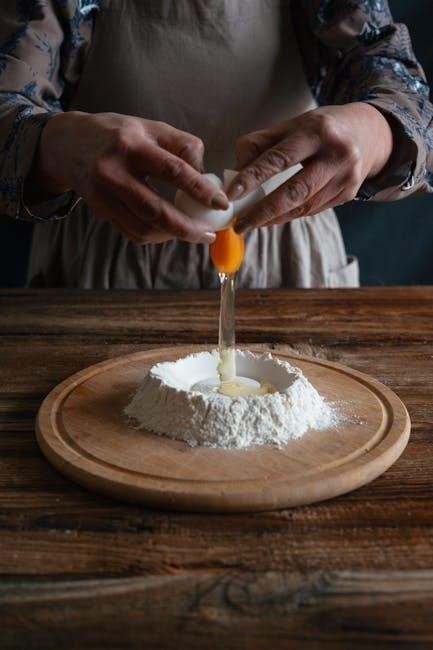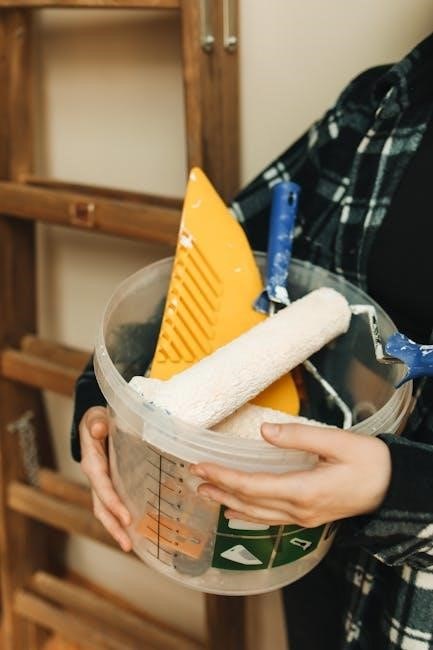The Ortega Method, also known as the Varasano method, is a popular intermediate technique for solving the 2×2 Rubik’s Cube efficiently. It is widely recognized for its simplicity and effectiveness.
1.1 Overview of the Ortega Method
The Ortega Method is a streamlined approach for solving the 2×2 Rubik’s Cube, designed for intermediate solvers. It involves three primary steps: orienting the first layer, orienting the last layer (OLL), and permuting both layers (PBL). This method is renowned for its efficiency and simplicity, making it a favorite among speedcubers. By focusing on orientation and permutation separately, the Ortega Method reduces complexity, allowing solvers to master the cube quickly. Its popularity stems from its logical structure and minimal algorithm set, ensuring a smooth learning curve.

1.2 Brief History and Popularity
The Ortega Method was developed by Victor Ortega as an efficient approach for solving the 2×2 Rubik’s Cube. Gaining popularity in the speedcubing community, it became a favorite due to its streamlined process. The method was created to simplify solving by breaking it into manageable steps, making it accessible to intermediate solvers. Its popularity soared as cubers embraced its logical structure and reduced algorithm set, allowing for faster solve times and easier memorization. Today, it remains a widely used and respected technique in the cubing world.
1.3Why Choose the Ortega Method for 2×2 Solving
1.3 Why Choose the Ortega Method for 2×2 Solving
The Ortega Method is a highly efficient and streamlined approach for solving the 2×2 Rubik’s Cube, making it ideal for intermediate solvers. It simplifies the process by reducing the number of algorithms needed, allowing for faster and more intuitive solves. This method is particularly popular among speedcubers due to its logical structure and ease of memorization. By focusing on orienting and permuting layers simultaneously, it offers a balanced approach that enhances both speed and accuracy, making it a favorite for those aiming to master 2×2 solving.

Step-by-Step Guide to the Ortega Method
The Ortega Method involves three straightforward steps: orienting the first layer, orienting the last layer (OLL), and permuting both layers (PBL). This structured approach ensures efficiency and clarity for solvers of all levels.
2.1 Step 1: Orienting the First Layer
The first step involves solving one face of the cube, typically the bottom layer (D face). Hold the cube with the D face on the bottom and focus on aligning all stickers to face downward. Twist the bottom layer to orient the stickers correctly, ensuring no mismatched colors remain. This step is foundational, as it sets the stage for the rest of the solve. Once the D face is fully oriented, you can move on to the next layer, maintaining the solved state of the first layer throughout the process.
2.2 Step 2: Orienting the Last Layer (OLL)
Once the first layer is oriented, the next step is to orient the last layer (OLL). This involves aligning the top layer’s stickers to face upward without disturbing the first layer. Use specific algorithms like R U R’ U’ or R U2 R’ U’ R U2 R’ to orient the top stickers. Focus on one piece at a time, ensuring each sticker faces the correct direction. This step requires precision and practice to maintain the solved state of the first layer while orienting the top layer.
2.3 Step 3: Permuting Both Layers (PBL)
After orienting both layers, the final step is to permute both layers (PBL) to solve the cube. This involves using algorithms to align the corners and edges without disturbing the orientation. Key algorithms include R2 U R’ U’ R U2 R’ and F R U R’ U’ F’. Execute these sequences to swap or cycle pieces into their correct positions. Practice these algorithms to master the Ortega method and achieve a solved cube efficiently. PBL is the last step, ensuring all pieces are in their proper places.

Algorithms for the Ortega Method
The Ortega Method relies on specific OLL (Orientation of Last Layer) and PBL (Permutation of Both Layers) algorithms to solve the 2×2 cube efficiently. Key algorithms include R2 U2 R U2 R2 and F (R U R U) F, which help orient and permute pieces. These sequences are essential for mastering the method.
3.1 OLL (Orientation of Last Layer) Algorithms
OLL (Orientation of Last Layer) algorithms are crucial for aligning the last layer’s corners and edges to their correct positions and colors. Key OLL algorithms include R2 U2 R U2 R2, F (R U R U) F, and R U R U R U2 R. These sequences help orient the final layer without disturbing the already solved pieces. Mastering these algorithms is essential for transitioning to the next step, PBL (Permutation of Both Layers). They are designed to be efficient and minimize moves, making them ideal for intermediate solvers.

3.2 PLL (Permutation of Last Layer) Algorithms
PLL (Permutation of Last Layer) algorithms are used to permute the corners of the last layer after orientation (OLL) is complete; The Ortega method includes five PLL algorithms, such as the T-perm, Y-perm, and U-perm, which are also commonly used in 3×3 solving. These algorithms ensure the final corners are placed in their correct positions without disrupting the orientation achieved in the previous step. Mastering these sequences is essential for completing the solve efficiently and accurately. They are concise and designed to minimize unnecessary moves, making them ideal for intermediate solvers.

Tips for Mastering the Ortega Method
Understand notation, practice regularly, and avoid common mistakes. Use downloadable PDF guides and video tutorials for better comprehension and efficiency in mastering the Ortega method.

4.1 Understanding Notation and Basic Moves
Mastering the Ortega method begins with understanding basic cube notation and moves. Familiarize yourself with standard Rubik’s Cube terms like R, U, F, and their combinations, such as R2 or U2. These notations represent face turns that are essential for executing algorithms efficiently. For instance, R refers to rotating the right face clockwise, while F denotes the front face. Understanding these moves is crucial for following OLL and PBL algorithms. Practice basic moves regularly to build muscle memory and improve speed.

4.2 Practicing Efficiency and Speed
Consistent practice is key to mastering the Ortega method. Focus on developing muscle memory by repeatedly performing OLL and PBL algorithms. Break down your solves to identify bottlenecks and improve weak areas. Incorporate finger independence exercises to enhance dexterity and control. Use online timers to track progress and aim for faster solve times. Regularly review algorithms to ensure accuracy and fluency. Start with slower, deliberate practice to build a solid foundation before increasing speed.
4.3 Common Mistakes to Avoid
When using the Ortega method, avoid rushing through algorithms, as this can lead to misalignment or incorrect moves. Ensure proper orientation of the cube during OLL and PBL steps. Misidentifying corner orientations is a frequent error, so double-check before executing algorithms. Overlooking parity issues can disrupt solves, so familiarize yourself with common cases. Additionally, avoid skipping the repetition of algorithms, as consistency is crucial for mastery. Regular review of fundamental concepts helps minimize these mistakes and enhances overall proficiency.
Advanced Techniques and Variations

The Ortega method can be enhanced by incorporating CLL (Corners of the Last Layer) for advanced solvers, offering 42 algorithms for precise corner orientation, and combining it with other methods for optimized efficiency.
5.1 CLL (Corners of the Last Layer) Method
The CLL (Corners of the Last Layer) method is an advanced technique within the Ortega system, utilizing 42 algorithms to orient and permute the last layer’s corners. After establishing one layer, CLL solves the remaining cube. Nine of its algorithms overlap with Ortega, while others derive from 3×3 OLL. This method is efficient for intermediate solvers, offering precise corner control. Tips for making the first layer efficiently and avoiding common mistakes are available in the CLL Method Tips video, making it ideal for those familiar with the Ortega method seeking to advance their skills.
5.2 Combining Ortega with Other Methods
For advanced solvers, combining the Ortega method with other techniques can enhance efficiency. Many integrate CLL (Corners of the Last Layer) for better corner control or use 3×3 OLL algorithms for edge orientation. This hybrid approach allows for a more personalized and optimized solving style. Resources like video tutorials and PDF guides provide insights into these combinations, helping cubers refine their skills and adapt to different solving scenarios while maintaining the core principles of the Ortega method.
Mastering the Ortega method enhances your 2×2 solving efficiency. Download the PDF guide for detailed algorithms and practice regularly to refine your skills and speed.
6.1 Recap of Key Concepts
The Ortega Method simplifies 2×2 solving into three main steps: orienting the first layer, orienting the last layer (OLL), and permuting both layers (PBL). It emphasizes efficiency and speed, making it ideal for intermediate solvers. The method relies on 7 OLL and 5 PBL algorithms, which are essential for mastering the technique. Regular practice and understanding notation are crucial for improving solve times. Downloadable PDF guides and video tutorials provide comprehensive resources for learners to refine their skills and achieve consistent results.
6.2 Encouragement for Further Practice
Consistent practice is key to mastering the Ortega Method. Start with short sessions and gradually increase your speed. Use online resources, such as PDF guides and video tutorials, to refine your understanding. Track your progress and aim to solve the cube in under 10 seconds. Stay motivated, and remember that improvement comes with dedication. With patience and persistence, you’ll unlock the full potential of the Ortega Method and become a skilled 2×2 solver.
Recommended Resources

Explore Ortega Method 2×2 PDF guides and video tutorials for comprehensive learning. These resources provide step-by-step algorithms, tips, and examples to enhance your solving skills effectively.
7.1 Downloadable PDF Guides
Downloadable Ortega Method 2×2 PDF guides offer a structured approach to mastering the technique. These guides include detailed algorithms, step-by-step instructions, and visual aids to enhance learning. Popular resources like Carolyn Chan’s algorithm list and Andy Klises’ speedcubing guide provide comprehensive coverage of OLL and PBL algorithms. Many PDFs also feature diagrams and video links for better understanding. These guides are ideal for intermediate learners seeking to improve efficiency and speed in solving the 2×2 cube. They are widely available online for easy access and practice.
7.2 Video Tutorials and Online Courses
Video tutorials and online courses are excellent companions to the Ortega Method 2×2 PDF guides, offering visual and interactive learning experiences. Platforms like YouTube and dedicated cubing websites host tutorials that break down each step of the Ortega Method. These videos often include algorithm demonstrations, common mistake corrections, and tips for improving speed and efficiency. Online courses provide structured lessons, quizzes, and progress tracking, catering to different learning styles and skill levels. They are ideal for learners who prefer visual guidance to master the Ortega Method effectively.



0 Comments